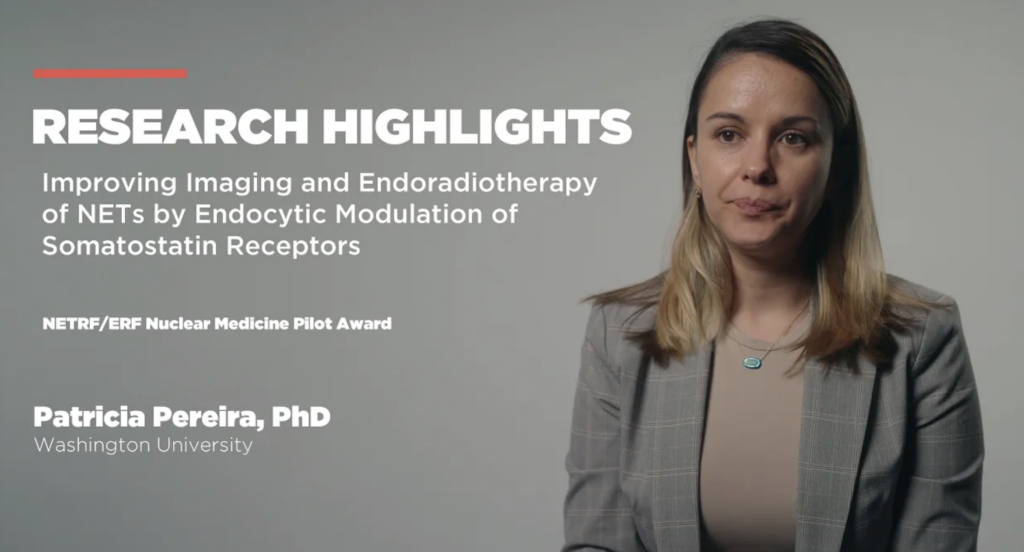Project title: Improving imaging and Endoradiotherapy of NETs by endocytic modulation of somatostatin receptors
Patrícia Ribeiro Pereira, PhD Washington University

- Status: Completed
- Year(s): 2022
- Grant Type: Collaborative
- Research Type: Basic
- Primary Tumor Site: Multiple
- Also seen in August 2022 eUpdate
Description
Study the membrane density of somatostatin receptors in neuroendocrine tumors to see if membrane trafficking (the process by which somatostatin receptors are distributed throughout the cell) can be modulated to enhance the efficacy of LUTATHERA.
What question will the researchers try to answer?
Somatostatin receptor 2 (SSTR2)-targeting radiolabeled peptides have high clinical potential for imaging and systemic radiotherapy of NETs. However, tumor heterogeneity contributes to inadequate tumor targeting and low drug delivery that contributes to disease progression. In this context, a homogeneous expression of tumoral SSTR2 is necessary for LUTATHERA to bind tumor cells. This project aims to modulate SSTR2 heterogeneity in ways that enhance LUTATHERA systemic radiotherapeutic efficacy.
Why is this important?
LUTATHERA has revolutionized the treatment of patients with neuroendocrine tumors that are positive for somatostatin receptors. However, not all tumors respond to LUTATHERA and tumor heterogeneity contributes to inadequate LUTATHERA delivery, ultimately leading to disease progression. By overcoming the heterogeneity of SSTR2 that characterizes non-responder NETs, LUTATHERA-tumor binding and endoradiotherapeutic efficacy can improve.
What will researchers do?
We have generated preclinical imaging data indicating that the temporal modulation of endocytosis increases tumor targeting of antibodies and other small molecules. In this proposal, we will temporally modulate endocytosis to increase the efficacy of LUTATHERA and extend the therapeutic benefit to neuroendocrine tumors of heterogeneous expression of SSTR2 (including SSTR2-low tumors). We will perform pharmacokinetic studies to define the dose of endocytic modulators necessary to temporally modulate membrane levels of SSTR2 for human translation and determine the potential dosimetric impact of endocytic modulation on clinical imaging and LUTATHERA endoradiotherapy.
How might this improve the treatment of NETs?
These preclinical studies will provide proof of concept for an innovative approach to increase the effectiveness of peptide receptor radionuclide therapy in NETs. In addition, it is likely that the results will contribute to the understanding of the mechanisms of SSTR2 in NETs molecular imaging and response to endoradiotherapy, thereby fundamentally advancing the fields of theranostics. These studies provide a basis for the next steps toward clinical translation that can impact many patients with NETs.
What is the next step?
The next important step is to establish a foundation for a clinical trial combining endocytic modulators of SSTR2 with LUTATHERA peptide receptor radionuclide therapy to prevent or delay the emergence of drug resistance in patients with NETs.
Outcomes:
Click below to watch an update from Dr. Pereira:
Our research focuses on improving the treatment of neuroendocrine tumors (NETs) using a therapy called 177Lu-DOTATATE, which targets a specific protein on tumor cells known as somatostatin receptor 2 (SSTR2). Unfortunately, not all tumors respond well to this treatment, especially those with low levels of SSTR2. Our study aims to increase the effectiveness of 177Lu-DOTATATE by using cholesterol-lowering drugs called statins, which help increase the presence of SSTR2 on the surface of cancer cells, making them more accessible to the 177Lu-DOTATATE therapy. Over the past two years, we have shown that statins can successfully enhance SSTR2 levels in both cell cultures and animal models of NETs. By using whole body imaging techniques, we confirmed that statin treatment improved the ability of DOTATATE to bind to and accumulate in tumor cells, leading to higher uptake of the therapy in tumors. We conducted detailed analyses to determine the optimal dosage of statins needed to maximize the effect without causing harm to healthy tissues. Our findings suggest that combining statins with 177Lu-DOTATATE could enhance the drug’s ability to target cancer cells, potentially increasing the efficacy of treatment for patients with NETs that have low SSTR2 levels. These results are promising as they offer a strategy to overcome resistance to current treatments, expanding the potential benefits of 177Lu-DOTATATE to a wider range of patients. This project contributes valuable data to the field of cancer research by demonstrating that modulating tumor biology can improve the efficacy of targeted therapies. We are currently preparing a scientific paper to share our findings and hope that our work will lead to clinical trials that can bring this improved treatment option to patients with NETs, ultimately helping to enhance survival rates and quality of life.
Additional Details
- City: St. Louis
- State: MO
- Country: United States
- Grant Duration: 2 years
- Grant Partner: Education and Research Foundation for Nuclear Medicine and Molecular Imaging
DISCLAIMER
NETRF funds laboratory research to understand the development of neuroendocrine tumors and translational research to explore new concepts in treatment. Research grant descriptions and research updates from NETRF are not intended to serve as medical advice. It can take years for research discoveries to be fully validated and approved for patient care. Always consult your health care providers about your treatment options.

